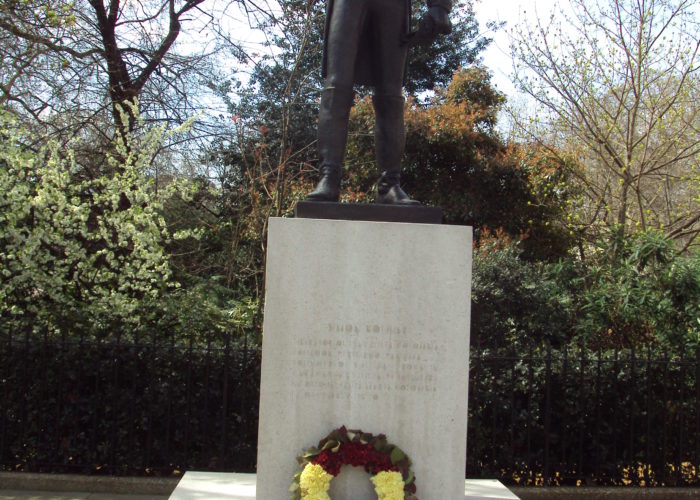Statue of Simón Bolívar
Theme: War and the international order, Spanish American wars of independence (1808-1833)
This is a statue of the South American revolutionary leader Simón Bolívar. Bolívar became known as El Libertador (‘the liberator’) and founding father of many modern South American countries, such as Venezuela, Bolivia and Columbia. He sought to harness the ideas and independence movements of earlier revolutions (including the French and American revolutions), and find a way to bring them to Central and South America – calling on the written word, the sword, and his own potent charisma to seize opportunities at a time of upheaval and war.
Simón Bolívar (1783-1830) was born in Caracas, in Venezuela, into a wealthy family. At that time, much of South America was under Spanish colonial rule. Like many children of the elite he was sent to Spain and then later France to be educated. Here he was exposed to the ideas of the Enlightenment which motivated his desire for reform, and later to overthrow Spanish dominion and create new independent states that extended greater rights to citizens. Having studied the American and Haitian revolutions, and witnessed Napoleon’s coronation in 1804, Bolívar developed a profound sense of what a single person could accomplish in the climate of revolutionary upheaval.
Revolutionary opportunities arrived thanks to the disorder created in Spain by European wars and Napoleonic occupation. Bolívar began his fight in earnest in 1808 with the campaign for the independence of New Granada (consisting primarily of present-day Colombia and Panama). In spite of numerous setbacks to his republican vision, and brutal warfare between groups with clashing allegiances and ambitions, victory was eventually achieved at the Battle of Boyacá on 7 August 1819.
Bolivar sought to consolidate this through a national congress. He fought with fellow regional leaders against a major force sent by the Spanish monarchy, securing independence for Venezuela at the Battle of Carabobo in 1821, and later (1822-1825) Ecuador, Peru, and Bolivia which was named after him.
Bolívar’s constitutional aims were to design strong links to unify the new independent nations in Latin America, creating the federal Gran Colombia, of which he was president from 1819 to 1830. But although widely celebrated and remembered for his military exploits, he expressed much frustration at the difficulties of organising and politically controlling fragmented populations, famously complaining that ‘all who served the revolution have ploughed the sea’.
This statue was produced for Belgravia Square in London, in 1974 nearly two centuries after Bolívar’s birth. It was unveiled by the then Foreign Secretary James Callaghan.
Did you know..?
Simón Bolívar’s full name is Simón José Antonio de la Santísima Trinidad Bolívar y Palacios Ponte y Blanco.
Sources & acknowledgements
This object description and its related educational resources were researched and written by our team of historians and education specialists. For further information see the item’s home museum, gallery or archive, listed above.
-
Did you know..?
Simón Bolívar’s full name is Simón José Antonio de la Santísima Trinidad Bolívar y Palacios Ponte y Blanco.
-
Education overview
You can access a range of teachers resources related to this object and more on our education page.
Please also see our glossary of terms for more detailed explanations of the terms used.
-
Curatorial info
- Production Date: 1974
- Creator: Hugo Daini
- Material: Bronze and Stone
-
Use this image
Image courtesy of Rept0n1x via wikimedia commons.
You can download this image for personal and educational use but please take note of the license type and rights holder information.
- License Type:



